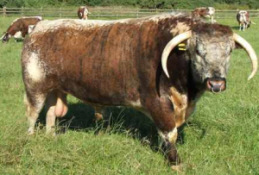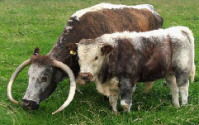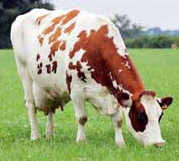



English Longhorn
History
English Longhorns (also known as Longhorns) are not related to the American or Texas Longhorn whose ancestors came from Spain. They do have a long and fascinating history linked to that of the great livestock pioneer of the 1700's, Robert Bakewell of Dishley.
The English Longhorn originated from the northern counties of England, it was used as a draught animal and its milk was used for butter and cheese. The creamy white horns were treasured by manufacturers of buttons, cups, cutlery and lamps. Fine slivers of clear horn were a poor mans' glass and many a household were grateful for the end product of these elegant long horns.
The most usual method of cattle keeping in those early times would have been one or more animals belonging to an individual, kept on common grazing, which were served by a bull owned by the Lord of the Manor. It was all a most haphazard and unsatisfactory method. There was no possibility of an organised breeding programme being carried out. The peasant farmers had to put up with what the Lord provided. As a result, cattle were long in the leg, narrow bodied and coarse, ideally designed for the plough.

Photo courtesy of Linton Longhorns, www.lintonlonghorns.co.uk |
Robert Bakewell (1725-1795), a man who was a revolutionary in the field of interbreeding became devoted to one aim - improving livestock to provide meat for the masses of people who went to work in towns in the Industrial Revolution.
He took horned heifers and crossed them with a Westmoreland bull to create the Dishley Longhorn, now called the English Longhorn. Through this new and careful selection of cattle he improved the size and quality (specifically its quick growth and heavy hind quarters) of this breed which became widely produced throughout England and Ireland until it was surpassed by the Shorthorn in the 1800's.
The breed declined rapidly for nearly 200 years and was becoming rare by the 1950's and 60's. The trend for producing cattle was increasingly cereal fed, housed cattle which pushed selection of cattle with shorter horns or polled to reduce injury. Thankfully it was rescued by the Rare Breeds Survival Trust in 1980. With the efforts of RBST and interest in extensively lean grass fed cattle it has made a dramatic comeback.
In 1981 a pair of Longhorns won the much coveted 'Burke Trophy' in the Interbreed Cattle Championship of The Royal Show, and a Longhorn bull was Reserve Interbreed Beef Champion at the Royal Welsh Show in 1994. In 1999 a Longhorn took the Interbreed Native Championship in the Leicester Show and a Longhorn pair were Reserve native Interbreed at the Counties Show.
Characteristics
English Longhorns are large lean beef cattle with an impressive sweep of horns that curve down to around the nose. These impressive horns are valued in the pedigree. The body may be any one of a wide range of brindle colours (including colours from red to grey) but they all have the characteristic white line or "finching" along the back and down the tail, which is passed onto their cross bred progeny. Cows range in height from 130 to 140cm and weigh 500 to 600kg. Males average 150 cm in height and 1000 kg in weight.

Photo courtesy of Linton Longhorns, www.lintonlonghorns.co.uk |
English Longhorn is renowned for its ease of calving. Prominent hook bones, deep pins and a roomy birth canal result in almost no recorded incidence of assistance being needed at birth. Longhorns have excellent milking ability and their long and level lactation help avoid a flush of milk at calving. They rear their calves very well. A 6% butter fat is not uncommon although no-one is currently milking them commercially.
They are excellent mothers and their docile nature makes them an easy breed to manage. Their breeding, longevity and relatively low body weight makes them very economical and inexpensive to feed.
A number of butchers are now stocking Longhorn beef as one of their traceable, quality products. The beef has a velvet texture and tastes delicious.
Statistics
The Longhorn is noted for its “feed responsive milk supply”. It is well known that it is the butterfat element of the milk which gives “bloom” to suckled calves. The Longhorn was renowned for the high butterfat of its milk which, in days gone by, was used in the making of famous cheeses like Stilton and Red Leicester. The lactation is long and level which helps to avoid a flush of milk at calving when the newborn calf cannot cope.
The combination of prominent hook bones with wide deep pin bones, whilst still retaining a level top line, produces a roomy birth canal at the right angle to minimise calving problems. This means that a Longhorn or Longhorn Cross Cow when put to a continental bull experiences little or no calving difficulties and thus forms a highly efficient, productive and profitable unit. She is an adaptable long-lived cow that can produce and rear big, growthy calves to any breed of bull.
Longhorn cows live to an unusually old age – and keep on breeding. Their hardiness and thriftiness together with their level lactation and ease of calving ensure that they do not place themselves under undue stress.
Whilst their horns may, to some, give an opposite impression Longhorns are noted for their exceptional docility.
The great overall length generally associated with the Longhorn is correlated with a rapid growth rate and lean carcase. It is a well established fact that intramuscular fat or “marbling” within meat is largely responsible for succulence, tenderness and flavour – the hallmark of beef with superior eating quality. Unlike many rival breeds, which require the laying down of excessive amounts of external fat before the formation of intramuscular fat can take place, a properly finished Longhorn carcase will benefit from “marbling” without such excess external fat cover.
Today’s Longhorns are clean, modern cattle, well capable of producing lean beef with superior eating qualities to suit today’s discerning market.
Distribution
The English Longhorn is growing in popularity and can be found in the UK, Ireland, Germany, Australia and New Zealand.
References (the above information was cited from the following sites)


